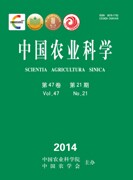-
Effects of Whole Field Soil-Plastic Mulching on Spring Wheat Water Consumption, Yield, and Soil Water Balance in Semiarid Region
- HOU Hui-zhi, Lü Jun-feng, GUO Tian-wen, ZHANG Guo-ping, DONG Bo, ZHANG Xu-cheng
-
Scientia Agricultura Sinica. 2014, 47(22):
4392-4404.
doi:10.3864/j.issn.0578-1752.2014.22.005
-
 Abstract
(
610 )
Abstract
(
610 )
 HTML
(
6 )
HTML
(
6 )
 PDF (2164KB)
(
661
)
PDF (2164KB)
(
661
)
 Save
Save
-
References |
Related Articles |
Metrics
【Objective】The main limiting factors which affect spring wheat productivity on Northwest Loess Plateau are drought, rainfall dynamics could not meet spring wheat water needs, and low temperature in spring. How to conserve the rainwater in soil efficiently, and use it at the spring wheat growth stage, is the most important method to increase spring wheat yield in this area. The aim of the study is to reveal the effect of whole field soil plastic mulching (i.e. the whole soil surface firstly mulched by plastic, and then spread around 1cm thick soil on plastic surface) on spring wheat seasonal water consumption, yield, water use efficiency and the soil water recharge in fallow period, further to assess its effect on inter annual soil water balance in semiarid region on Northwest Loess Plateau. 【Method】The spring wheat (Triticum aestivum Lunchun 27) selected as test material, a field experiment was conducted from 2011 to 2013 on the Dingxi Experimental Station of Gansu Academy of Agricultural Sciences (104°36′ E, 35°35′ N) , which located on northwest Loess plateau. The designed three treatments are whole field soil plastic mulching and bunch seeded (FMS), whole field mulching and bunch seeded (FM), and uncovered and bunch seeded (CK). The seasonal soil water content, spring wheat biomass, yield and spring wheat yield components were recorded, as well as the rainwater fallow efficiency, evapotranspiration, water use efficiency, harvest index, and reproduction allocation index were calculated.【Result】The evapotranspiration among the three treatments were not differed significantly in 2011 and 2012, but the evapotranspiration of FMS was significantly higher than CK in 2013. From seeding to jointing stage, the FMS and FM significantly increased spring wheat evapotranspiration by 27.2% and 9.6% in dry year, 52.2% and 44.6% in wet year, respectively, as compared with CK. The evapotranspiration of FMS and FM was not significantly different at each spring wheat growth stage. However, the evapotranspiration of FMS shown an increasing trend in wet year (i.e. 2012 and 2013) as compared with FM, especially, this trend was more obvious in 2013. In fallow period, the soil water from 0 to 80 cm soil profile of FMS and FM was recharged by 25.4 mm and 18.3 mm, lower than CK by 2.2 and 9.3 mm. However, in 80-200 cm soil profile, the soil water of FMS and FM recharged by 78.0 mm and 71.0 mm, higher than CK by 30.0 mm and 23.1 mm, respectively. In the three years experimental period, the 0-200 cm profile soil water storage of FMS, FM and CK was increased by 23.8, 22.5 and 12.4mm, as compared with before sowing in 2011. The rainwater fallow efficiency of FMS was 30.5%-52.6%, higher than CK by 12.8%-109.5%, than FM by 4.5%-40.9%, spike grain number and kilo grain weight of FMS were significantly higher than CK (P<0.05). Harvest index and reproductive allocation index of FMS was 0.42-0.49 and 0.59-0.67, averagely increased by 32.54% and 35.37% than CK, respectively. The spring wheat yield and water use efficiency of FMS reached 1 750-3 180 kg·hm-2 and 5.5-11.5 kg·hm-2·mm-1, increased by 40%-220% and 27%-239% than CK, respectively. Especially, the increased extent of yield and water use efficiency was higher in dry year than that in wet year. The yield and water use efficiency of FMS were increased by 26.2% and 28.2% in the dry year (2011), and by 20.9% and 14.8% in wet year (2013), as compared with FM, the significant difference were observed. It indicated that the FMS could significantly increased spring wheat yield in wet year, and adapted drought environment in dry year, resulted in sustainable higher yield, as compared with FM.【Conclusion】FMS efficiently increased soil water storage before spring wheat sowing and early spring wheat growth stage, as well as increased spring wheat water consumption from seedling to booting stages, caused the increment of grain number per spike and reproductive allocation index, expanded sink capacity by increasing spring wheat spike grain number and kilo grain weight, resulted in higher yield and water use efficiency than FM and CK treatments. Additionally, FMS recharged the soil water from 0 to 200 cm at fallow period completely, so it is beneficial to sustain the soil water balance through years.









